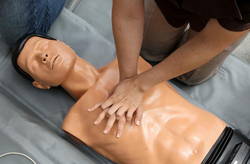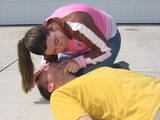|
This page requires
Adobe Flash Player 9.0 (or higher). |
||
|
|
||
|
CPR - cardiopulmonary resuscitation
1. Attempt to wake victim. If the victim is not breathing (or is just gasping for breath), call medical assistance immediately and go to step 2. If someone else is there to help, one of you call medical assistance while the other moves on to step 2. If the victim is breathing, see the Tips section at the bottom of this page for what to do. 2. Begin chest compressions. If the victim is not breathing, place the heel of your hand in the middle of his chest. Put your other hand on top of the first with your fingers interlaced. Compress the chest at least 2 inches (4-5 cm). Allow the chest to completely recoil before the next compression. Compress the chest at a rate of at least 100 pushes per minute. Perform 30 compressions at this rate (should take you about 18 seconds). If you are not trained in CPR, continue to do chest compressions until help arrives or the victim wakes up. It's normal to feel pops and snaps when you first begin chest compressions - DON'T STOP! You're not going to make the victim worse. 3. Begin rescue breathing. If you have been trained in CPR, after 30 compressions, open the victim's airway using the head-tilt, chin-lift method. Pinch the victim's nose and make a seal over the victim's mouth with yours. Use a CPR mask if available. Give the victim a breath big enough to make the chest rise. Let the chest fall, and then repeat the rescue breath once more. If the chest doesn't rise on the first breath, reposition the head and try again. Whether it works on the second try or not, go to step 4. If you don't feel comfortable with this step, just continue to do chest compressions at a rate of at least 100/minute. 4. Repeat chest compressions. Do 30 more chest compressions just like you did the first time. 5. Repeat rescue breaths. Give 2 more breaths just like you did in step 3 (unless you're skipping the rescue breaths). 6. Keep going. Repeat steps 4 and 5 for about two minutes (about 5 cycles of 30 compressions and 2 rescue breaths). If you have access to an automated external defibrillator (AED), continue to do CPR until you can attach it to the victim and turn it on. If you saw the victim collapse, put the AED on right away. If not, attach it after approximately one minute of CPR (chest compressions and rescue breaths). 7. After 2 minutes of chest compressions and rescue breaths, stop compressions and recheck victim for breathing. If the victim is still not breathing, continue CPR starting with chest compressions. 8. Repeat the
process, checking for breathing every 2 minutes (5 cycles or so), until help
arrives. If the victim wakes up, you can stop CPR.
Hands-Only CPR These guidelines are
meant for untrained rescuers. Trained rescuers may also use these steps
for witnessed cardiac arrest. |
||
|
|
||
 There
is no substitute for learning cardiopulmonary resuscitation (CPR), but
emergencies don't wait for training. These instructions are for conventional
adult CPR. If you've never been trained in CPR and the victim collapsed in
front of you, use hands-only CPR.
There
is no substitute for learning cardiopulmonary resuscitation (CPR), but
emergencies don't wait for training. These instructions are for conventional
adult CPR. If you've never been trained in CPR and the victim collapsed in
front of you, use hands-only CPR.